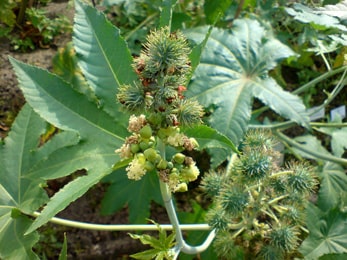Eranda, Castor (Ricinus communis) – Properties, Benefits, Uses & Dosage

Description of Eranda Plant
Ricinus is a fast growing tree which is evergreen, herbaceous and semi-woody large shrub gain height up to 5mt and width is 4.5m wide. The glossy leaves are green to purplish in color and are palmate, with 5-11 deeply incised lobes and have long petioles. Stems contain hollow nodes and are green to reddish in color. Male flowers are on the lower spike of the flower with yellow colored anthers and the female flower is egg-shaped capsules, reddish brown and is thickly covered with soft flexible spines. Each capsule contains three seeds that look like fat, swollen and are deadly poisonous with brownish mottling.
General information
Original castor oil plant, castor bean plant, the hand of Christ all are common names of Ricinus. Eranda and gandharav hasta are Hindi names of castor. In Ayurvedic medicine system, it is used in various preparations due to its medicinal properties. Ricinus is one of the strong laxatives. All parts of this plant are poisonous but seeds contain ricin which is a poisonous compound. It is the best remedy to cure tooth ailments and constipation. Castor seed oil is very beneficial for the sufferers of rheumatism. It is commonly available remedy to cure disorders in children.
Purification of eranda seeds
Seeds of Ricinus are highly toxic and for the purification, seeds are fomented in coconut water for three hours. Then these seeds are washed and dried for the preparation of medicines.
Special note about Ricinus communis
Seeds of this plant are highly toxic due to the presence of chemical compound ricin. It is the most poisonous plant in the world. In adults fatal dose is considered to be about 5-10 seeds. Overdose may cause nausea, vomiting, diarrhea, hypotension, tachycardia, seizures and it may lead to spontaneous death. Symptoms may begin in 2-4 hours or it may be delayed for 36 hours. Ricin is also used in the preparation of various insecticides and pesticides.
According to Acharya Charak:-
एरण्डमूलं वृष्यवातहराणाम्॥ (च.सू २५)
From all the herbs which have the capability for pacifying vata dosha and are aphrodisiac in nature, eranda is the best.
Habitat
This plant is originally native to the Middle East and northeastern Africa. Later it becomes distributed as a weed everywhere in tropical and sub-tropical regions of the world. Mainly it grows in waste farms, rocky hillsides and on the edges of cultivated lands.
Classification
- Kingdom – Plantae
- Order – Malpighiales
- Family – Euphorbiacaeae
Names
- Latin Name – Ricinus Communis
- Hindi Name – Erand, Redi, Erend
- English Name – Castor, African Coffee Tree, Arandi
- Bengali Name – Rehri, Bhairenda
- Telugu Name – Amudamu
- Bengali Name – Bherenda, Rehri, Bhaerand
- Tamil Name – Amanakku, Amanakkam
- Marathi Name – Erandi
- Malayalam Name – Avanakku
- Gujarati Name – Diveligo, Diveli Erandi
- Kannada Name – Haralu, Manda
- Farsi Name – Bed Anjeer
- Arabian Name – Khirva
- Assam Name – Eri
- Nepali Name – Areta, Orer
- Punjabi Name – Aneru, Arand
- Chinese Name – Pee – Ma
- Egyptian Name – Kiki
- Sinhala Name – Endaru
- Persian Name – Ved Anjir
Ayurvedic Properties
| Hindi / Sanskrit | English | ||
| Rasa | Madhur, Katu, Kashaya | Taste | Sweet, Pungent, Astringent |
| Guna | Snigdha, Sookashma, Teekshna | Physical Property | Unctuous, Minute, Sharp |
| Veerya | Ushna | Potency | Hot |
| Vipaka | Madhura | Metabolic Property (After Digestion) | Sweet |
Effects on Doshas
It balances Vata and Kapha doshas.
| Charak Samhita | Sushrut Samhita |
|
Vidarigandhadi, Adhobhaghara, vata sanshamana |
The Ancient Verse about Erand (Ricinus communis)


Ancient Reference – Bhavprakash Nighantu Guduchyadi Varga, Page no. 285- 286
- White erand and red erand are two varieties of this herb. Shuklerand, aamand, chitter, gandharavhast, panchangul, vardhman, dirghdand, vaydambak, vatari, tarun and rubbak are synonyms of white erand. Rakterand, rubuk, urubuk, rubu, vyagrhpuch, vatari, chakshu and uttanpatrak are various synonyms of red erand. Both are heavy with hot potency and sweet taste and are used to cure inflammation, migraine, and severe pain, relieves pain in lower back and bladder region, abdominal disorders and fever. It is also used to cure cough, asthma, leprosy and is useful in rheumatoid arthritis.
- Leaves of Ricinus are used to pacify vata dosha and used to cure cough, worm infestation, dysuria, and bleeding disorders. Soft leaves of this plant is used in abdominal tumors and relieve bladder pain. Fruit of this plant is hot in potency and used to treat abdominal tumors, vata imbalance, enlarged liver and spleen, piles and abdominal disorders. Fruits are pungent in taste and stimulate digestive fire. Seeds are best used in abdominal ailments and purgation.
Rajnighantu
According to Rajnighantu, there are two types of erand:
- Shweta ernda (White Ricinus)
- Rakta eranda (Red Ricinus)
Practical uses of Ricinus communis
- Castor seeds and seed oil is used from ancient times to cure disorders like rheumatism, worm infestation, severe constipation, and abdominal disorders.
- External application of this oil is used to relieve boils, furuncles, and various skin related disorders.
- It is used to cure vata dosha related disorders like arthritis and facial paralysis.
- This herb act as a diuretic and very effective in dysuria, urine retention and other urinary tract related infections in both males and females.
- Castor oil is locally massaged over breast in lactating mothers to increase the flow of milk.
- Daily massage of oil from seeds of this herb help in reducing dandruff and promoting hair growth.
- The Root bark of this herb is emetic and purgative. A Decoction of leaves is very beneficial for the sufferers of lumbago and sciatica.
- Castor seeds are also used for birth control.
Parts used
- Roots
- Leaves
- Fruits
- Seeds
Dosage
- Seed oil : 3-5 drops
- Powder : 1-3gm



